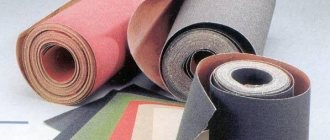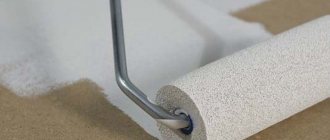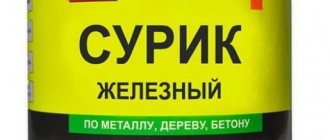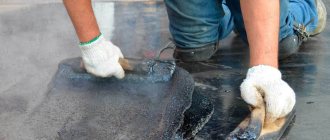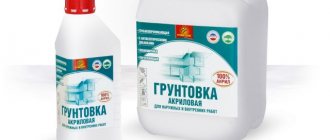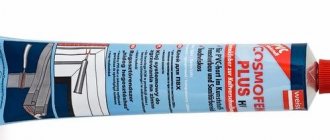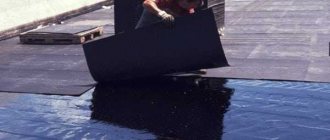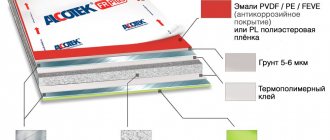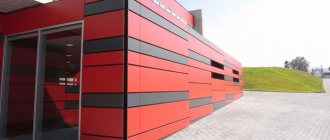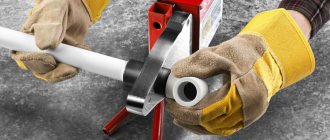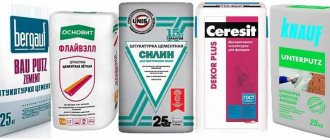Despite the emergence of an increasing number of new building materials and technologies used for the construction of roofs of houses and other structures, there are those types of materials that have been used for many decades. Roofing felt also belongs to the category of such coatings, the technical characteristics of which allow it to be used for various needs, including the creation of reliable roofs.
Ruberoid: technical characteristics
What kind of material is this?
Ruberoid is a material produced in rolls and used in the construction industry to create waterproofing layers and construct roofs. It consists of fiberglass or special roofing cardboard, which is thoroughly impregnated with a bitumen composition, then covered with refractory bitumen and sprinkled with a special material that prevents the individual layers of material from sticking together. Talc, sand, asbestos and other materials can be used for sprinkling. Coarse-grained topping, which is applied to the front side of the roofing material, is necessary to ensure a long service life, resistance to precipitation and other weather conditions.
What is the difference between roofing felt and roofing felt?
Euroroofing material
On a note! The composition of roofing felt may additionally include various polymers that improve its resistance to low temperatures. This material is used mainly in cold northern regions. In this case, roofing material is able to withstand air temperatures down to -50 degrees.
Ruberoid has a number of advantages, and therefore is an indispensable material when creating a roof. It is inexpensive, has excellent resistance to water, is sealed, easy to use, and soft. But the disadvantages of the coating include the fact that it is quite fragile, breaks easily and quickly becomes unusable when exposed to the open sky during heat or excessive air humidity. That is why the material is usually laid in several layers at once - then it can withstand maximum loads . And the bitumen mastics used during installation help to further increase the strength of the coating. It is also worth remembering that roofing felt is prone to fire.
Laying roofing felt on a wooden roof
Like all roof waterproofing elements, roofing felt is laid from bottom to top, with an overlap (the width of the overlap is marked by the manufacturer using a dotted line along the entire roll), from the perimeter to the ridge
For fastening, you can use special “roofing felt” nails
Laying flexible tiles over roofing felt
Prices for flexible tiles
Flexible roof tiles
Reinforced
The reinforced base gives additional mechanical strength to the roofing felt. It is produced on fiberglass, reinforced with a special mesh, and coated with a bitumen-polymer composition. Such thick roofing material can withstand high loads, and due to the reinforcement, they are distributed throughout the entire layer. It is not susceptible to fungus formation and does not rot.
The topping here can be slate or granite, which gives additional reinforcement to the material on the outside. The thickness of such roofing material is from 3 millimeters. One layer of it replaces 3–4 layers of classic roofing felt. It has high adhesion to almost any substrate. Can be used as a top layer for concrete, brick, wood.
Reinforced roofing felt glitters in the sun and is gray in color. Its service life is at least 15 - 18 years. Rating: solid 5. This roofing material is laid according to the principle characteristic of all euroroofing felt, second only to self-adhesive roofing felt in ease of installation.
Features of use
Ruberoid has found wide application in the construction industry and is used to create structures for any purpose. But best of all, it has proven itself as a waterproofing layer during roof construction. Quite often the material is used to create foundations, finish basements, and also for waterproofing purposes.
Armored roofing felt
On a note! Flat roofs on buildings for various purposes are almost always insulated from moisture using roofing felt.
The material can also be used to create a roof directly (usually in the construction of garages, sheds and other ancillary buildings), it is often used to repair roofs, and also as a soft lining when installing various types of tiles, ondulin, and corrugated sheets.
Ruberoid is one of the most commonly used roofing materials
How to choose?
When choosing roofing felt, they evaluate the service life, complexity of installation and appearance of the roofing in relation to the price of the material . Inexpensive types of roofing felt are usually used for outbuildings, garages, and sheds. The roof of a residential building is made from modern types of rolled material with an increased service life and good aesthetics.
Alternative materials
Waterproofing roofing felt is sometimes replaced with roofing films and membranes that have the appropriate properties. Underground structures, foundations, are protected with liquid coating waterproofing based on bitumen, cement or polymer materials.
A type of roofing roofing material is flexible bitumen shingles . This coating is installed according to the principle of self-adhesive roofing felt. Flexible tiles come in a wide range of shapes and colors.
Dimensions and thickness
Roofing material can have various parameters determined by standards and GOST. They will depend on its brand.
Table. Main characteristics of roofing felt.
| Index | Value thresholds |
| Width | 1 000, 1025, 1050 mm |
| Roll weight | About 22-25 kg |
| Square | 10, 15, 20 sq. m. |
| Weight 1 sq.m. | About 2 kg |
| Content of bituminous substances | No more than 0.8 kg/sq.m. |
| The ratio of the mass of impregnated bitumen to the cardboard base | 1,25-1,4 : 1 |
| Tensile strength | About 216-333 N |
| Density | 0.35-0.4 kg/sq.m. for roofing and 0.3 kg/sq.m. – for lining type |
Waterproofing a concrete floor with roofing felt
The material, when bent around a 20-30 mm rod, should not crack at a temperature of no more than 18-25 degrees. Some deviations in size are allowed: for example, in area they can be no more than 0.5 m2, and in the width of the roll - no more than 5 mm.
On a note! For the construction of the roof, roofing material with a thickness of at least 4-5 mm can be used. A coating up to 3.5 mm thick is applicable as a lining for roofing material.
Application
Special codes that mark products help to understand the nuances of using a particular brand of roofing material. The designation includes capital letters, followed by the mass of 1 m² of cardboard in grams. The data reflects the density and strength of the coating. The letters can be deciphered:
- the first “P”, this designation is constant, does not change, means roofing material;
- further “K” or “P” is read as “roofing” or “lining”;
- the latter is a type of topping, features of roofing felt.
The letters at the end of the designation carry the following information about the sprinkles:
“K”, “M”, “P”, “Ch” - respectively, coarse or fine-grained, dusty, in the form of scales.
Additionally there are:
“E” - level of increased elasticity;
“C” - enhanced color fastness.
Differences between RPP and RKP brands can be observed in application:
- The first type is suitable for protecting the foundation as a waterproofer and laying roofs with a slight angle of inclination. A variety of RPP is used for the finishing layer. cover individual areas with roofing felt. Repair work is carried out using mastic, which is used to treat the damaged area, apply a waterproofing agent, and additionally cover it with a layer of mastic;
- RKP roofing material is used exclusively for roofing work both inside and outside, but using it instead of lining insulation is unprofitable; the material is more expensive.
Application of roofing felt for foundation waterproofing
There are other types of markings that reflect the use of different bases:
- HPP - fiberglass is used, bitumen impregnation is covered with polyethylene, a simple, affordable type of roofing material;
- CCP - the composition is similar to the previous one, the difference is in the use of special granules for protection from sunlight and increased strength;
- TKP - a layer of fiberglass- based roofing material is protected from below with polyethylene, and from above with a special coating. The best option for inversion roofs;
- TPP – the basis is frame fiberglass, suitable for forming the bottom layer.
When using an insulator, the performance properties are largely determined by the materials used in production. Roofing felt, which is based on:
- fiberglass (T) - with improved characteristics;
- fiberglass (X) – not tensile strength;
- polyester (E) – the lowest strength.
Thus, you can understand the choice and use of roofing felt:
- according to markings indicating the structure of the material, the level of surface protection;
- in terms of coating density.
Installation of roofing felt on the foundation
Types of material
There are several options for classifying roofing felt. It may differ in some technical characteristics, type of topping, laying method or density. So, based on the type of topping, several categories of roofing material can be distinguished.
- With coarse bedding . The material is considered universal and is used for various purposes, including waterproofing roofs. Coarse powder may only be present on the front side of the material.
- Dust coated. To create it, chalk or talc is used, which is applied to both sides. This type is used only to create the lower layers of the roof.
Roofing felt
- With quartz sand . This type of coating is used for waterproofing. The coating can be applied to both sides of the roofing material.
- With mica or slate topping . It is applied depending on the type of material on one or both sides of the coating. The material is used during construction to create the outer roofing layer.
- With stone chips . This type of topping is applied only to the front side of the material, while the back side is treated with a dust-like type of topping. The material is applicable only for creating an external coating.
Fine-grained powder
Also, all types of coating described can be divided into the following categories.
- Glassine - ordinary roofing material, where the base is cardboard impregnated with bitumen. The material is laid in at least 3-4 layers - this thickness will allow it to be used for at least ten years.
Roofing felt is made from construction cardboard
- Rubemast is a type of material that is weldable. It has the same properties as glassine, but installation is carried out using heating.
- Fiberglass rubber (stekloizol, steklomast) differs in that it is based not on cardboard, but on fiberglass. Very durable coating with a service life of about 12 years.
- Euroruberoid is a material with a base made of fiberglass, polyester or fiberglass. Very durable, does not rot, is laid in 2-3 layers and lasts at least 25 years. The amount of impregnation in it is about 2-5 kg per 1 m2 of base.
- felt is a durable roofing material that is impregnated with special compounds and has a coating of stone chips. The base is cardboard.
Liquid roofing felt
Where is roofing felt used?
On a note! There is also liquid roofing felt on sale, which resembles mastic in appearance. It includes various polymer additives. The material is not heated before use and is usually used for roof repairs.
Prices for roofing material
Ruberoid
Uniflex
Polymer-bitumen material can become part of the roofing pie. It can be used for waterproofing. The coating contains artificial rubber. It is this that makes this roofing material frost-resistant and heat-resistant at the same time.
The operating temperature of installation has the following range from – 200 °C to + 95 °C.
Uniflex is divided into three types:
- Lower.
- Upper.
- For ventilated roofs.
The lower uniflex is offered to the consumer without topping and can be used as a waterproofing layer or as the base of a roofing pie. The top uniflex has a coating and is used as an independent roofing.
Uniflex for ventilated roofs is used to construct a single-layer or two-layer (this must be specified in the labeling) roofing pie. Excellent for repairing soft roofs, even when it is not possible to remove the old covering.
In the photo - roofing material
The markings for this material are as follows:
- The first letter E is the basis of uniflex - polyester.
- The first letter X is the basis of uniflex fiberglass.
- The first letter T is fiberglass frame.
- The second letter K means there is sprinkles.
- The second letter P means no sprinkles.
The service life of the material is up to a quarter of a century. Uniflex occupies a leading position among all euroroofing felts, not inferior in technical characteristics to reinforced ones.
Video about Uniflex and its features:
Brands of roofing felt
According to GOST, roofing felt has all kinds of grades. Knowledge of their features and properties will help you make the right choice of coating for a particular purpose.
GOST 10923-93. Ruberoid. Technical conditions. Downloadable file (click the link to open the PDF in a new window).
GOST 10923-93
Roofing roofing felt
RKP 350 is considered a roofing product and has a dust-like layer of coating on both sides. It is based on cardboard, which has a density of at least 350 g/m2. It is used for the construction of roofs of various types (recommended for creating reinforced concrete roofs in the first place), suitable for laying under soft materials, and can act as a roofing covering itself. Inexpensive and has excellent waterproofing properties.
Ruberoid RKP 350
RPP 300 is considered a lining, usually used in the construction of foundations, for covering roofs with small slope angles, various engineering structures, and is used for sealing ventilation, as a lining layer.
RKK 350 is a material for flat roofs that has a coarse-grained coating, which gives it additional strength. This type of roofing material is usually used in regions where weather conditions are unfavorable - there is often hail, strong winds, and it often rains.
Table. Technical characteristics of the main brands of roofing felt.
| Brand | RKP 350 | RPP 300 | RKK 350 |
| Water absorption over 24 hours, % | No more than 2 | No more than 1.8 | 2 |
| Heat resistance, C° | 80 | 80 | 80 |
| Water resistance, h | 72 | 72 | 72 |
| Width, m | 14 | 1 | 1 |
| Length, m | 15 | 15 | 10 |
| Breaking force, N | 274 | 216 | 312 |
| Weight, kg | 24-27 | 20 | 25 |
| Weight of powder and bitumen layers, g/m2. | Not less than 800 | Not less than 500 | Not less than 800 |
Also, other types of roofing felt can be used for roofing construction. For example, RKK 400 , which has a large thickness (5 mm) and coarse-grained coating. The density of its base is 400 g/m2. The material is used as the top layer of the roof pie.
RPP 200 has a dust-like coating, is quite thin, but has good waterproofing ability. Cardboard density is about 200 g/m2. Suitable for creating moisture-proof layers.
RPP 300 is considered one of the best options for creating a waterproofing layer. It has a fine dusty coating, and the density of the cardboard base is 300 g/m2. Service life is about 10 years as a lining.
Ruberoid RPP-300
Ruberoid in rolls
Types of soft roofing
The modern market offers about 60 types of these products. Each type of product has its own purpose and characteristics. The most common are the classic types of bitumen roofs, among which four main types can be noted:
- Tol. These products were very popular in Soviet times. The covering consists of cardboard, which is impregnated with tar or coal tar compounds. The canvas has a coarse-grained coating on both sides. Nowadays, roofing felt is used for waterproofing or for covering temporary buildings. It is worth noting that bitumen products have a short service life.
- Rubemast. This roofing covering is a modified and higher quality analogue of conventional roofing felt. When producing rubemast, cardboard is impregnated with special bitumen, which contains mineral additives. The top protective layer is a topping of granite chips. The density of Rubemast is about 2000 g/sq.m. m, which is 5 times more than a conventional bitumen roof.
- Steklomast. A distinctive feature of this material is that instead of cardboard, the base is fiberglass. The density of the product is from 3000 to 4000 g/sq.m. m. The service life of Steklomast is about 15 years. Also, it can be noted that Steklomast is a frost-resistant material that remains flexible even at low temperatures.
- Euroroofing material. These products are very common due to their frost resistance, as well as their long service life, which ranges from 20 to 30 years. Euroroofing material is made from durable fiberglass and bitumen, which contains synthetic rubbers. It is also worth noting that thanks to colored coatings, the roof can acquire a beautiful and unusual appearance.
How to deal with the markings?
Each roll of coating has its own marking, which will indicate the intended use of the material, its features and indicators. It is applied to the reverse side of the coating or to the label and consists of numbers and letters. Let's try to figure out how to read it correctly.
Understanding the markings of roofing felt
So, the letters are deciphered as follows:
- the first P means what kind of material it is - it’s not hard to guess that it’s roofing felt;
- next comes the letter K or P, which indicates the scope of use of the coating, that is, P is lining, and K is roofing material;
- the third letter in the marking - K, P, M or Ch - informs the buyer about the type of sprinkle. For example, scaly, dusty, coarse-grained or fine-grained layer;
- the three-digit number indicates the density of the cardboard. For example, 350 g/m2. The indicator reports that there are about 350 g of cardboard base per 1 m2.
Marking of standard roofing material
There may be another letter at the end of the marking. For example, E will tell the buyer that the material is stretchy, and C will indicate colored sprinkles. The letter C indicates that the roofing material is based not on cardboard, but on fiberglass.
On a note! If the roofing material is colored, then the designation C can also appear at the beginning of the marking, immediately after the designation P - roofing material.
Popular colors of roofing felt
Armored
Many manufacturers are trying to give their material additional functions. Some even point out that RKK 350 roofing felt is already an armored roofing material. In fact, such a characteristic can only be assigned to a product with a base density of 500 grams per 1 m2.
It is important to comply with one more condition. The topping of armored roofing material should be colored. Any color other than black and gray absorbs sunlight better, thereby extending the life of the roofing material.
In fact, what the topping will be made of is not so important; it can even be colored foam. The main thing is that it will adhere tightly to the armored roofing felt and for 10–15 years it will be able to neutralize the harmful effects of ultraviolet radiation on the roofing felt.
The cost of the material is from 350 rubles per roll. Rating: solid 4.
Choice of coverage
To use this material as a lining, it is recommended to choose the brands PM 350, PM 420, PM 500, but for the outer layer of the roof, RK 420 or RK 500 are suitable. Fused types of material are especially popular now.
Among the manufacturers we can note the following:
- "TechnoNIKOL";
- "Balakovorezinotekhnika";
- "Aquaizol";
- "Hydrol-Roofing";
- "Blasto."
Roll materials TechnoNikol
There are other manufacturers of roofing felt. When purchasing, it is best to take into account, first of all, those companies that have existed for many years. Such manufacturers value their reputation and are unlikely to produce low-quality material. Unfortunately, there is always a risk of running into a fake.
When choosing a material, you should pay attention to the following aspects:
- integrity of the canvas;
- absence of kinks, cracks;
- roll density;
- quality of base impregnation (determined by the color in the section - it should be black with a slight brownish tint).
On a note! Tears in the material are allowed only at the edges of the roll, but they should not be longer than 30 mm.
No. 7. What should you pay attention to when purchasing?
When purchasing roofing material, you must carefully inspect it:
Each roll must have a marking on it, which can be used to judge the possible area of use of the material. In addition, roofing felt must have a mark of compliance with GOST 10923-93 ;- the material should not have cracks, folds or tears. Cracks are allowed only on the edge and no more than 2 cm long;
- in the section of roofing material there should be no light areas and areas without impregnation, the impregnation layer should be uniform;
- rolls must be packed in thick paper and transported on special stands.
Installation methods
Installation of roofing felt necessarily includes preparation of the base - this is grouting the concrete slab with cement or laying a wooden base made of boards on the rafters. Also, the material itself is rolled out and leveled so that it straightens a little. It is kept in this position for 24 hours, after which the topping is removed from the bottom layer with kerosene.
Roofing felt rolls are being rolled out
To glue the material, you will have to stock up on bitumen mastic, which can be used hot or cold. Hot is prepared in a filler-bitumen ratio of 1:8. The filler can be chalk, sawdust, asbestos, peat chips, which are sifted and poured into bitumen. Next, the mixture is heated over a fire and stirred until smooth. If cold mastic is used, the bitumen is melted and dehydrated with diesel fuel or kerosene.
We cover the roof with roofing felt
Laying roofing felt begins from the bottom of the roof, valley, and gutters. The material is glued with an overlap of about 20 cm of individual strips on top of each other. During gluing, it is important to ensure that no swelling occurs. The built-up roofing felt is laid using a torch or hair dryer.
Ruberoid is divided into types
On the construction market you can find several types of roofing felt:
- Rubemast. Here, binder bitumen is used, which improves the properties. Rubemast is laid on the roof without mastic. To lay it, you need to melt the bottom cover layer.
- Steklomast. Similar to rubemast. Only the basis here is fiberglass.
- Modified roofing felt or euroroofing felt. The basis is fiberglass. Sometimes polyester is used as a base. A mixture of bitumen and additives is used as a coating. Has very good technical characteristics. It can also be laid by melting the layer.
- Tol . Its production has almost ceased. The base is cardboard, which is then coated with a composition of slate and tar.
Installation instructions
Let us consider in detail how the process of covering the roof of a small wooden shed with this type of material occurs.
Step 1. Measurements are taken from the roof and the required amount of coating is calculated. In this case, future overlaps of the material must be taken into account.
The required amount of material is determined
Step 2. The roof surface is cleared of debris, nails, and carefully leveled. It is important to remove all elements that could damage the material in one way or another.
Old nails are removed
Step 3. If necessary, wet cleaning of the roof and further drying of the base can be used. If it is not dried, then rotting processes may begin under the roofing felt.
Wet cleaning of the base
Step 4: The roof deck is carefully inspected for damage or rot. All damaged areas must be replaced with new ones and repaired.
Inspecting the surface for damage
Replacing the damaged area
Step 5. Installation begins from the bottom of the roof. The roll is spread along the eaves, but for ridge roofs, installation can begin from the ridge - in this case, in the upper part the covering should hang down by about 30 cm.
Installation starts from the bottom of the roof
Step 6. The edge of the roofing felt is aligned so that it hangs about 2 cm from the edge of the roof - this will allow water to drain to the ground.
The edge of the material should hang down about 2 cm
Step 7. The material is fastened using galvanized fasteners from the edge of the roof from where the roll was rolled out.
Fastening roofing felt
Step 8. The material is pulled towards the other edge of the roof, opposite the relatively fixed section of the material. The effort applied is moderate - the roofing felt is easy to tear.
Roofing felt is stretched
Step 9. The roofing felt is nailed to the base with nails with wide heads in increments of 30 cm around the perimeter of the roof and 60 cm in the upper part of the section of roofing felt, which will be covered by the overlap of the next section. It is important not to damage the integrity of the material with the caps.
The material is nailed
Step 10. The next strip of roofing material is rolled out in the opposite direction relative to the previously laid one. It is laid with an overlap of 20 cm on the previous one.
The second strip of roofing felt is being rolled out
Step 11. The roof ridge is covered with two pieces of roofing material so that both strips extend onto the roof ridge itself.
The ridge is covered with roofing felt on one side
Laying the second section overlapping the ridge
Step 12. Nail heads are treated with mastic or resin so that they are further protected from moisture.
Nail heads are treated with mastic
Video - How to cover a roof with roofing felt?
Useful videos
Types, application, which one is best used and for what: Roof repair using a shovel, a burner and a couple of friends - watch a video tutorial: Technology for laying roofing felt with your own hands using a gas burner: See how roofing felt is made, the whole process step by step: Focusing on the types and the quality characteristics of roofing felt, it is easy to select the necessary material for specific purposes. Any interesting information? Please share in the comments.
We recommend: Show Room of building materials: why it is important to carefully check the reputation of the supplier, what types of building materials are most in demand, what can result from improper transportation of bricks
Service life and consumption during roof installation
Although roofing felt is characterized by a fairly low cost, it should be noted that material on a cardboard base, if installed correctly, can have a service life of 15 years or more. When performing roofing work, it is optimal to use it with a minimum cardboard density of 400 g/m². The number of layers is also important. The worse the quality of the material, the more of them are needed. It is optimal to use 2-7 layers. The more you put them in, the longer the roof will last. The fact is that roofing felt is characterized by drying out and cracking over time. Moreover, the lower layers are the last to be destroyed. If there are a lot of them, then it takes longer to dry.
Advantages and disadvantages of roofing felt
The roofing option has many advantages:
- Low cost per square;
- Possibility of installation on roofs of any shape and slope;
- High waterproofing characteristics;
- Standard roll sizes, greatly simplifying the preparation of estimates;
- Easy to install and transport.
This photo shows a simple installation of such a roof.
Among the disadvantages of this material are:
- Fire hazard and high flammability;
- Service life up to 10 years;
- Low strength;
- Sensitivity of bitumen to temperature changes.
How to cover a roof with roofing felt
The roof is covered with roofing felt in stages. In this case, a special wooden flooring is installed under the soft material.
Stages
Construction of a soft roof includes the following steps:
- Fixing roofing felt sheathing on the roof frame.
- Treat the base with a protective primer, which should penetrate into all cracks.
- Laying roofing material (with an overlap of 5 to 20 cm) using bitumen mastic, applied in a layer of 5 mm either over the entire roof area or only on the edges of the strips of material.
- Treating the soft flooring with a thin layer of mastic and installing a second layer of roofing material perpendicular to the previous one.
The mastic is carefully and portionwise poured and spread on the roof with a spatula. - Folding the edges of the soft covering under the overhang and fastening them with slate nails.
Ruberoid is placed under the cornice and secured with nails - Laying the next layer of material using mastic (if necessary, create a multi-layer roofing carpet).
- Fastening the finishing layer of roofing felt with wood slats or a metal plate.
Sheathing for roofing felt
The design of the sheathing is determined by the function of the structure (for living or not) and the number of layers of the roofing pie with the inclusion of roofing felt.
Sparse sheathing, made up of boards laid out at intervals of 10–15 cm, is installed specifically for the roof of an outbuilding, as well as a roof where roofing material is laid under a sheet covering. In the latter case, a counter batten is installed on a soft canvas at intervals of 50–60 cm, on top of which the main batten is mounted and sheets of the finishing roofing material are laid.
For laying roofing felt on the roof of an outbuilding, a sheathing is suitable, the boards of which are located at a distance of 10 cm from each other
A continuous sheathing under roofing felt, which serves as the main roof covering, is created when the house is residential. The raw material for its construction is a plywood sheet with a thickness of 1 cm or a board with a thickness of 1.5–2 cm.
If the room directly under the roof will also be residential, then the sheathing should be made heavy-duty. To do this, you need to use plywood 2 cm thick and lay it in 2 layers. An alternative solution is to use continuous sheathing made of boards 30 mm thick.
Continuous roofing felt sheathing is most often constructed from durable plywood
Laying roll material on a wooden surface
There are two technologies for laying roofing felt on a wooden surface - parallel and perpendicular to the ridge.
On a wooden roof, roofing felt can be laid either along the ridge with an overlap of 5 cm between the rolls, or perpendicular to it with an overlap of one sheet over another of 10 cm
Installation of roofing felt strips along the ridge board is possible in two situations:
- the material serves as a water barrier for the rafters and as a backing for the final roof covering;
- The soft fabric must be laid in 2-3 layers, and each time in different directions.
If the method of laying roofing felt parallel to the ridge turns out to be suitable, then installation work can be performed as follows:
- Starting from the eaves board, cover the roof with strips of material in a horizontal direction, making overlaps of 5 cm.
- Nail the panels or glue them together using mastic.
- Cover the roof with a second layer of material so that the next strips of roofing material are located parallel to the ridge, overlapping the joints of the first layer, or are perpendicular to the eaves strip.
When laying parallel to the ridge, the second layer of roofing material can be placed both along the first and across it
Installation of roofing felt across the ridge is carried out when the rolled sheet is assigned the role of the main roof covering. The step-by-step process is as follows:
- The rafter system is covered with a sheathing made of plywood sheets with a thickness of 1 to 1.6 cm or boards with a thickness of 1.5–2 cm.
- Using mastic or nails, overlapping the edges of the strips by 10 cm, the required number of layers of roofing material are glued to the wooden base. Work begins from the leeward area of the roof.
Roofing felt is attached to the sheathing with nails every 50–60 cm - Strips of each layer of material are placed on the other side of the roof so that the ridge is not vulnerable to moisture. With this installation method, you can do without a metal profile on the ridge. The seams are pressed to the roof surface with a roller.
Strips of material are bent to the other side of the roof so as not to install a metal ridge on top - The strips of the last layer of soft covering are folded under the cornice and secured with a pressure strip and nails.
- To strengthen the attachment, wooden slats or metal strips are nailed to the finished soft covering.
Wooden slats ensure reliable attachment of roofing felt to the base of the roof
The second and all other layers of roofing material are laid on the roof, overlapping the seams of the already laid material, and always only a day after installation of the first sheet. This is how long it takes for the mastic to harden.
Video: how to lay roofing felt on wood sheathing
Why does a rolled bitumen roof need topping?
But what happens to roofing felt over time, why does it collapse and become damaged? The fact is that prolonged heating in the sun seems to expel the most volatile components from it, namely bitumen and glue. As a result, the entire base gradually turns into crumbling plastic. Therefore, the more reserves of shredders in the cardboard base, the more it prevents the degradation of the roofing carpet.
Stone pavement also provides excellent protection from sunlight:
By the way, the type of topping directly affects the scope of application of roofing material. For example, rolls of coarse-grained topping are used as top and bottom layers of coating. At the same time, they are laid on both cold and hot mastic. And color is more an aesthetic choice than a practical one:
But roofing felt with scaly topping already has limitations. For example, one-sided can only be placed on hot mastic, and double-sided can be placed on both cold and hot. But fine-grained topping is already suitable for roofing felt only as waterproofing or the lower part of the roofing carpet.
Area calculation and installation features
Most roll materials are packaged in 15 meter lengths. The width of the strips is 1 ± 0.5 m. When calculating the area, possible dimensional errors are not taken into account.
Following the simple formula a*b, we get 15*1=15 m2. It turns out that each roll contains 15 squares of coverage. If the seller rolled up a large length, we take this into account when calculating the required amount of roofing material.
An important feature: the strips are glued to the surface using bitumen mastic, heating the material with a burner. The sheets must be overlapped: for the transverse direction - 10 cm, for the longitudinal direction - 15 cm.
- How many meters are there in a roll of roofing felt?
- Ruberoid or glass insulation: choosing waterproofing
Pros and cons of roofing felt
Today, an important advantage of roofing felt is its low price. However, it is short-lived. The roofing felt will serve you well for about 5 years. The bitumen included in its composition tends to soften at temperatures above 50 degrees. Under the influence of low temperatures, roofing felt begins to crack. The cardboard base deteriorates over time. To install a roofing felt, you will need a large amount of this material, since the thickness of its installation is usually 4-5 layers. This installation ensures extended service life.
Read also: Provence style in the interior (100 photos)
Installation of a rolled roof over a continuous plank sheathing: 1 - working flooring; 2 - protective flooring; 3—coverless roofing material; 4 - roofing felt; 5 - mastic; 6 - roofing steel; 7 - strip of roofing material.
Producing a roof using liquid roofing felt is not a difficult job. Roofing mastics (self-leveling roofing) are applied to a base of flat slate or metal in several layers, like paint. The service life of biturel is 2 years, the most durable mastics - one-component polyurethane - are in use from 5 to 10 years.
What is roofing felt? Purpose, types and popular manufacturers What is roofing felt? Purpose, types and popular manufacturers Types and types of roofing felt: roofing grade RKK 350, lining RKP 350, for flooring RPP 350, armored, liquid and self-adhesive What is roofing felt? Purpose, types and popular manufacturers What is roofing felt? Purpose, types and popular manufacturers What is roofing felt? Purpose, types and popular manufacturers
Rubemast is stronger and more durable. The thickness of its lower layer makes rubemast more flexible and prevents the formation of small cracks. Steklomast will serve you for about 15 years. It has sufficient plasticity and is frost-resistant (it cracks at temperatures below 15 degrees). To create a roof made of fiberglass, no bitumen mastic is required. During installation, its bottom layer is melted with a gas-air burner. Another advantage of steklomast is its economical use. It is usually laid only a few layers thick compared to roofing felt.
